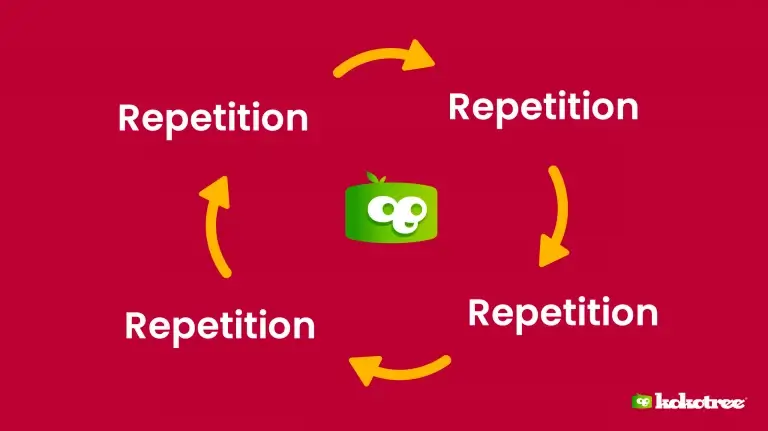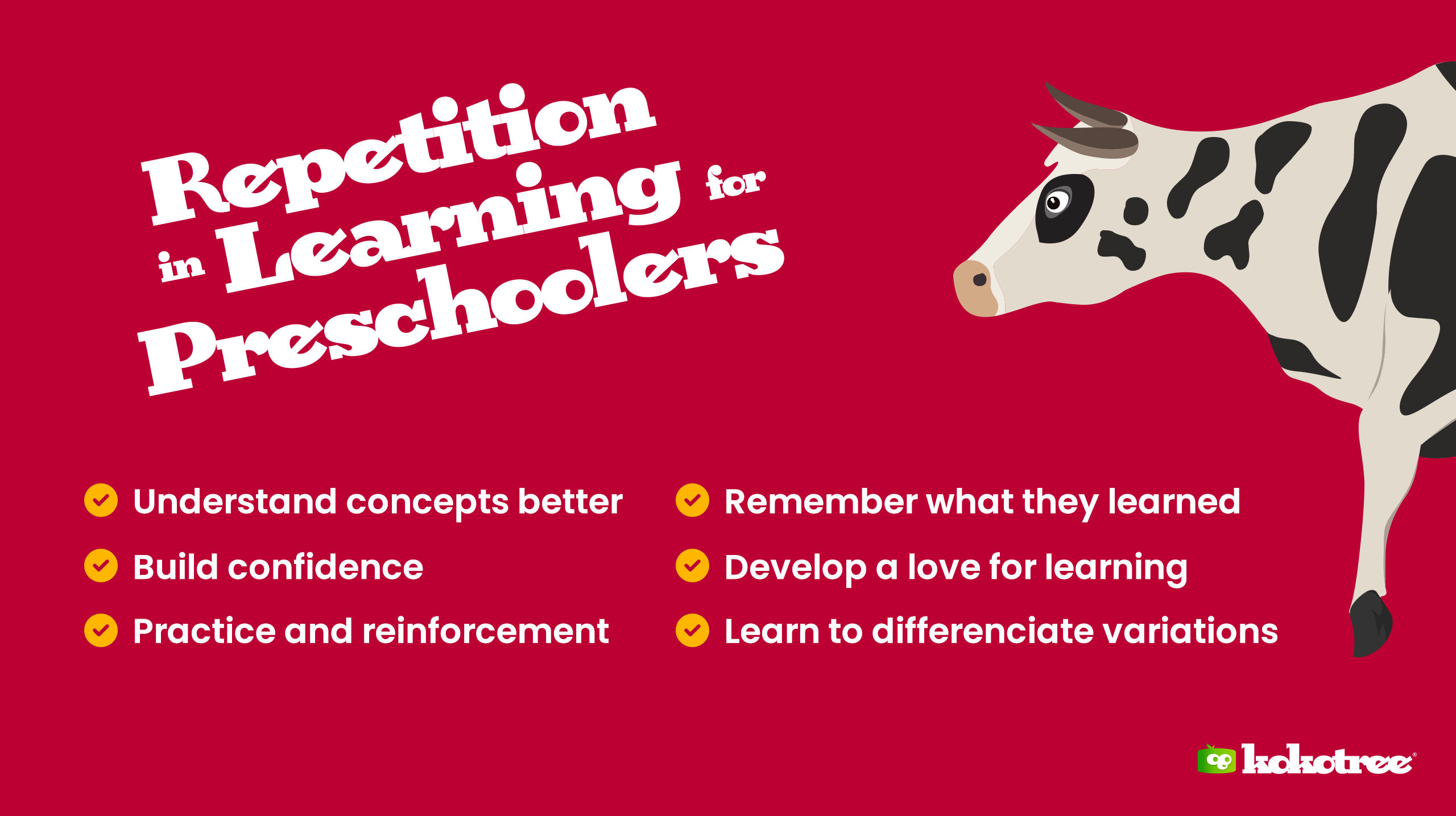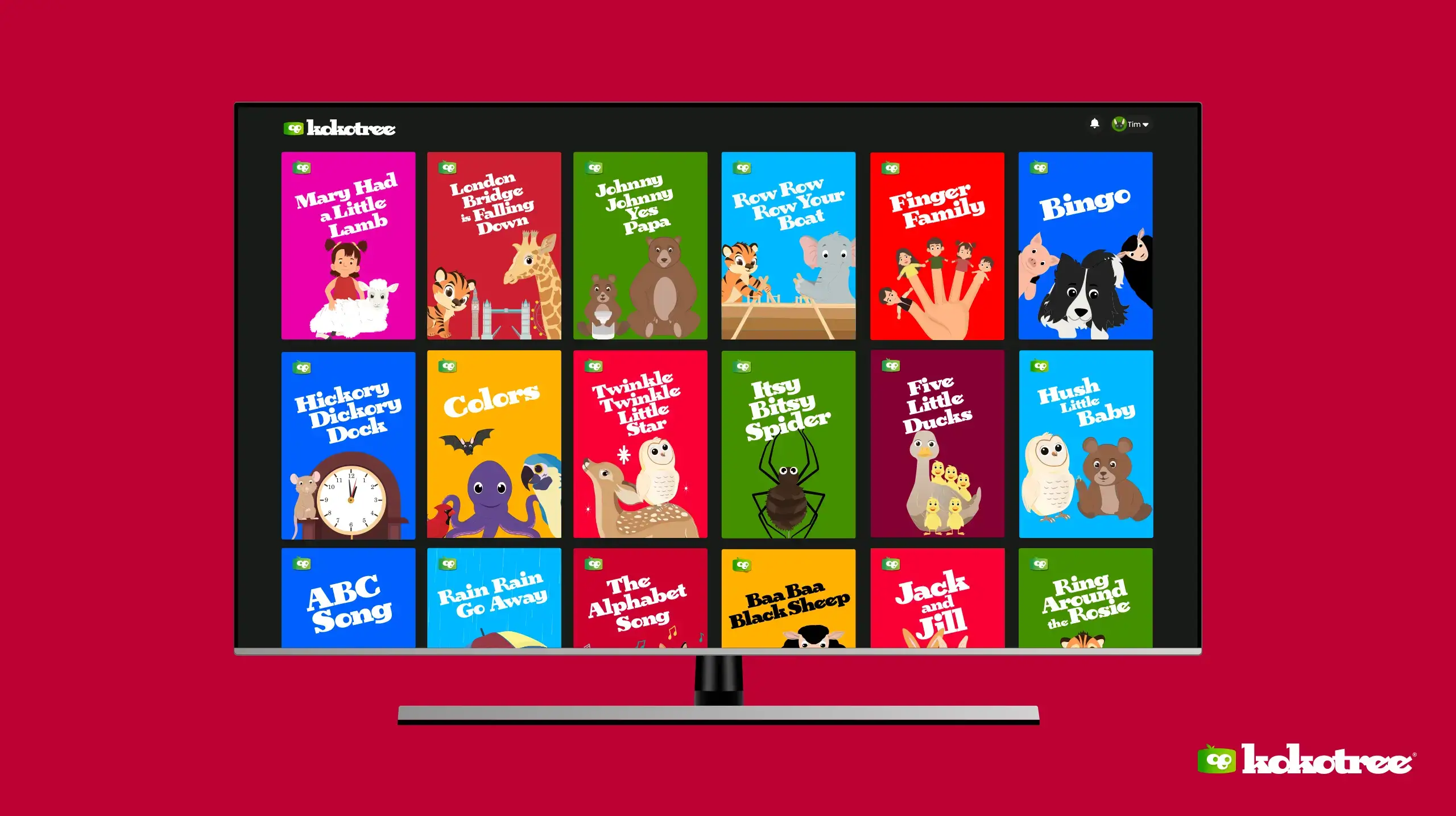

Repetition is essential when it comes to learning for toddlers because it helps them better remember the information they are being taught.
It can be helpful to repeat stories, nursery rhymes, and activities multiple times so your child can learn them thoroughly. By doing this, you are helping your child get a head start on their education.
There are learning apps for preschoolers, like the Kokotree learning app, that give your toddler and preschooler education videos meant for repetition.
When it comes to learning, repetition is critical. And for toddlers and preschoolers, it’s vital. That’s because their brains are still developing and forming new connections, so the more they learn and repeat something, the better those connections will be.
Research shows that if toddlers and preschoolers repeat something ten times, they will remember it better than if they only hear it once. So, don’t be afraid of repetition if you want to help your toddler learn and remember things better. Embrace it!
Repeating a task or activity multiple times can help toddlers learn and master new skills.
This may include reading the same story multiple times, practicing a skill through different activities, or observing another child completing the task.
Repetition can come in many forms, so finding what works best for each toddler is essential. By providing opportunities to repeat and practice new skills, toddlers can develop a strong foundation for learning.
The importance of repetition in learning for toddlers can be seen through their need for routine and familiarity with their surroundings. When toddlers know what to expect, they feel safe and secure, allowing them to focus better on learning.
This is why it is important to provide a predictable routine for your toddler and plenty of opportunities for repetition in their learning.
Parents can begin using repetitive learning with their child during preschool age, which ranges from 3 to 5 years old. This is an ideal time to introduce consistent patterns and routines to reinforce essential skills, such as language, motor, and cognitive abilities, as children at this age are highly receptive to learning through repetition.
Repetition is the foundation of learning for young children.
However, all children benefit from review and practice. Repetition helps embed new learning so that it becomes automatic. It also helps children feel more confident and competent. When a child struggles to learn something, additional repetitions can be helpful.
Try breaking down the task into smaller steps and repeating each step several times. You can also try using various methods to help your child learn, such as games, songs, or rhymes.
Rote learning is a basic form that can help children memorize simple facts and concepts. Although rote learning is not the only way to learn, it can be helpful, especially for younger children.
For example, you may use rote learning to help your child learn:
Rote learning is not just about repeating something over and over again. It’s also about understanding what you’re learning. For rote learning to be effective, children must know what they are memorizing.
For example, if you’re helping your child learn the alphabet, it’s not enough for them to repeat the letters A, B, C, and D… They need to understand that each letter represents a sound and that those sounds can be combined to create words. Teaching your child phonics can help them understand the relationship between letters and sounds.
Rote learning can be a helpful way to learn simple facts and concepts. But it’s not the only way to learn. Children must rely more on critical thinking and problem-solving skills as they age.


Get free parenting tips, news, updates, and content from Kokotree.
As you can see, repetition is vital in learning for toddlers. It helps them understand early learning concepts better, remember what they’ve learned, build confidence, and develop a love of learning. So, if you want to help your toddler learn and remember things better, don’t be afraid of repetition. Embrace it!
The more a toddler repeats an activity, the more connections their brain makes to enable them to learn that task. This is because toddlers have immature nervous systems requiring more repetition to develop strong neural relationships. Repeating an activity allows toddlers to improve their skills and understand new concepts. To learn optimally, toddlers need to be exposed to various learning experiences. Repetition plays a vital role in helping toddlers learn and remember further information.
Repetition is essential for toddlers as they learn and form brain connections. It helps them strengthen the neural ties necessary for learning new things. This is why they often repeat activities and tasks to make learning easier and more efficient.
Repetition helps children learn; it helps with memory, language development, and more. A child can learn new things more quickly if they have heard the information before. Repetition allows them to understand new concepts and ideas better when repeated regularly. If you want your child to learn something new or improve their skills at something, repetition will help them get there faster!
Once babies begin to understand the basic rules of their world, they use repetition to build on these rules and make new connections. One of the best ways to expand your toddler’s vocabulary is by repeating what they say. This will help them learn that new words are essential and give them a way to communicate with others.
For example, if she says “doo doo” when she sees the dog, repeat it to her: “Yes! That’s a doggy! You said ‘dog.’” Once she gets used to hearing herself talk in such a way (and seeing how much you value what she has said), she’ll be more likely to repeat her word in future situations where dogs are around.
Repetition is one of the most effective ways to help your toddler understand and remember a concept. It can also give him confidence, making him more receptive to learning new things.
Repetition helps children learn:
One way to encourage repetition and language growth is through reading books. You can introduce new words, concepts, ideas, or things you want your toddler to learn. Parents need to read with their children often as it helps them develop a love of books and learning. The more you read with your child, the better they will understand what is being said when someone reads aloud. Reading together also helps strengthen the bond between parent and child, which builds confidence in both parties’ ability to communicate effectively verbally and non-verbally (through actions).
A great tip is to choose a book with repetition, such as “Brown Bear, Brown Bear What Do You See?” by Bill Martin Jr. or “The Cat in the Hat” by Dr. Seuss. These books help keep your child’s attention focused while also allowing them to hear new words and phrases being used repeatedly.
Don’t forget to point out things along the way as you’re reading and say the words aloud so your child can see how the word is spelled. You can also ask them what they think will happen next in the story. This will help engage their minds and get them thinking about the concepts presented to them.
When your child is learning a new skill, repetition is critical. It’s essential to break the task down into small, manageable steps, so they don’t get overwhelmed. For example, if you’re teaching your child how to tie their shoes, start by having them practice with unthreaded laces. Once they’ve mastered that step, you can move on to the next one.
It’s also important to be patient and keep a positive attitude when teaching new skills. Children learn best when they feel comfortable and safe. They’ll likely pick up on that and become discouraged if you get frustrated.

Songs and rhymes are a great way to provide lots of repetition that children enjoy. Many studies have been done on the effects of repetition on learning and memory in children. One study found that high-quality educational programs accelerated language acquisition. Watching safe, educational nursery rhyme videos is a great way to encourage language development. You, as a parent, can also sing while watching the rhyme.
Repeating important information helps toddlers learn and remember it better. Studies have shown that repetition is a critical factor in learning for children. It can help them learn new words and develop their language skills. It can also help them remember things they learn in school. So if you want your child to learn and remember as much as possible, provide plenty of opportunities for repetition. Songs, rhymes, and educational videos are all great ways to encourage learning through repetition.
Toddlers enjoy repetition because it helps them learn and understand new concepts. Repetition allows them to practice and master new skills, providing a sense of familiarity and predictability that can be comforting.
For example, if a toddler is learning a new word, they may ask an adult to repeat it several times to understand its meaning better and how to use it. Repetition helps them to solidify their understanding of the word and to feel more confident using it.
In addition, toddlers are in the process of developing their cognitive skills and building their knowledge base. Repetition helps them to reinforce what they have learned and to make connections between new information and what they already know. This is especially important for young children, as it helps them to build a strong foundation for further learning.
Overall, repetition is a natural and vital part of the learning process for toddlers and young children. It helps them learn and understand new concepts, providing a sense of security and familiarity that is important for their development.
Repetition can be a valuable tool for helping toddlers learn new concepts and skills. Parents can use repetition in a variety of ways to help their toddlers learn, including the following:
While repetition can be an effective way to help toddlers learn, parents and educators must strike a balance. Too much repetition can lead to toddler boredom or frustration and may also limit their exposure to new experiences and information. Parents and educators must vary the activities and experiences they offer toddlers to keep them engaged and interested in learning.
Toddlers tend to enjoy repetition until around the age of 3 or 4. At this age, they may start showing a greater interest in exploring new experiences and information and lose their preference for repetitive activities. However, this can vary from child to child, and some children may continue to enjoy repetition for extended periods.
Teachers can incorporate repetition into their lesson plans for toddlers in various ways. You can use the same songs, stories, or activities multiple times to help toddlers learn new concepts and skills. They can also use repetition to reinforce what toddlers have learned and help them practice and master new skills. Teachers must strike a balance and vary their lesson plans to keep toddlers engaged and interested in learning.
Parents must balance repetition with the need to expose toddlers to new experiences and information. One way to do this is to vary the activities and experiences they offer toddlers. Parents can mix up the books and stories they read to their toddlers or offer a variety of toys and activities that allow toddlers to explore and learn differently. It is also essential for parents to pay attention to their toddler’s interests and to offer experiences and activities that are tailored to their interests and needs.
The use of repetition can lead to boredom or frustration for toddlers if it is not balanced with new experiences and activities. To mitigate these risks, parents must vary the activities and experiences they offer toddlers and pay attention to their interests and needs. Parents can also mix up how they use repetition by changing the order of activities or introducing new elements to everyday activities. This can help to keep toddlers engaged and interested in learning.
Your child’s brain is like a sponge; it needs to soak in information to make connections. Repetition helps children learn the rules of their world and language, remember things they have learned before, and even learn new words.
We hope this article has helped you understand the importance of repetition in helping your toddler learn. It’s important not to overdo things so they become bored with what they’re hearing. Still, playing games, singing songs, and reading books that use repetition are excellent ways to help them develop their language skills and improve their memory.
—–
If you want your child to learn through repetition, you might like our educational app for kids—because they provide lots of repetition for learning. And they’re so much fun, too!




